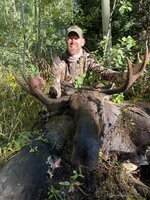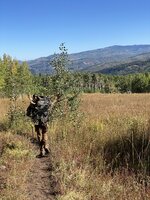Hey guys,
Since I posted in this forum looking for info earlier this year, I thought I'd follow up with some details about my successful bow hunt.
Here were a few takeaways I would have liked to know before I started on this process:
1. There is a ton of good data available out there for research.
I drew a season-choice tag for units in the White River NF/Flattops. Full disclosure - before submitting for the unit, I did absolutely no prior research. I had a very low number of points so I never expected to draw - just figured I'd throw my name in the hat instead of just paying the application fee. Per GoHunt stats I had about a 1.9% chance to draw this unit compared to 1.5% for others, that's why I picked it. If I had more points, I would have done a lot more background study as the area doesn't have a huge overall moose population and access is tough.
One other big benefit for research is the data CPW publishes. Go to the hunting statistics webpage for moose and read up on the antler measurement data. They no longer provide lat/long of moose kills but they do post the drainage where they were killed. Look for where the most moose were taken over the past few years. Check these areas out in detail on your online mapping system. See what makes them different than surrounding areas and check them out in the field if you can. That was a huge help for me. I had also been in touch with outfitters about packing out my moose and they also suggested some good areas.
2. Scout in-person as much as possible, particularly if you will be hunting solo.
Less for finding moose but more for understanding the area. I had never hunted in that unit and it was mostly wilderness so trailheads, roads, and (importantly for me) dispersed camping was limited. It would have been hard to determine this if I only did e-scouting. I also hung some game cameras - all of which showed moose at one time or another. Every year I say I will scout in the summer but rarely do. This is a once-in-a-lifetime tag so I would bail on a few other summer weekends and get after it.
3. If you are bow hunting, try to avoid the muzzleloader season.
The opening day of moose season corresponds with the opening of muzzleloader in CO. I have nothing against muzzleloader hunting (in fact I have vowed to get into it a number of times when bull elk hang up just out of my bow range) but there were way more people in the woods and I didn't see nearly as many moose. All the moose I encountered allowed me to get well within bow range. I wouldn't let it stop me from getting out there, just something to consider when planning what weeks to hunt. Certainly, as this is the first week of moose season, the weather may also play a factor. See below.
4. Focus on cooler, rainy weather
I hunted days where it was in the 70s and bone dry and days in the 40/50s and rainy. Moose were much more active on the colder, rainy days. I'm always eager to get out the first weekend of bow season but it is usually way too hot for much activity outside of first/last light.
5. Take your time with the shot
Every moose I interacted with allowed me to come quite close and in most cases, even walked towards me. They didn't spook like deer or elk, even when they were downwind of me. Take your time and make a better shot than I did so you don't have to wait so long for them to die.
6. Use an outfitter to pack out your meat if you are a good distance from your vehicle
My moose was down 3.5 miles from the truck. My friend and I packed it out in three trips over two days. Fortunately, the moose died right off a trail and the pack out was downhill. Still, we should have called in the professionals. The last pack out nearly killed us. Even if you plan to get one down near your vehicle, have an outfitter or two in your back pocket who can help you. You want to end your hunt with high-fives and cold drinks, not thinking you won't physically make the final 100 yards to the truck.
7. Bring extra game bags and coolers
Shiras moose are the smallest subspecies of moose but they are still huge. I brought seven big game bags, two 150 qt coolers, and one 52 qt cooler. I could have easily used two more game bags and another big cooler.
This was just my experience hunting for about six days over the 2022 season - your mileage may vary. Feel free to PM me with any specific questions as I'd be more than happy to help out any other CO moose hunters. Good luck to those still getting after it and thanks to those who provided insight on other posts in this forum as well!


Since I posted in this forum looking for info earlier this year, I thought I'd follow up with some details about my successful bow hunt.
Here were a few takeaways I would have liked to know before I started on this process:
1. There is a ton of good data available out there for research.
I drew a season-choice tag for units in the White River NF/Flattops. Full disclosure - before submitting for the unit, I did absolutely no prior research. I had a very low number of points so I never expected to draw - just figured I'd throw my name in the hat instead of just paying the application fee. Per GoHunt stats I had about a 1.9% chance to draw this unit compared to 1.5% for others, that's why I picked it. If I had more points, I would have done a lot more background study as the area doesn't have a huge overall moose population and access is tough.
One other big benefit for research is the data CPW publishes. Go to the hunting statistics webpage for moose and read up on the antler measurement data. They no longer provide lat/long of moose kills but they do post the drainage where they were killed. Look for where the most moose were taken over the past few years. Check these areas out in detail on your online mapping system. See what makes them different than surrounding areas and check them out in the field if you can. That was a huge help for me. I had also been in touch with outfitters about packing out my moose and they also suggested some good areas.
2. Scout in-person as much as possible, particularly if you will be hunting solo.
Less for finding moose but more for understanding the area. I had never hunted in that unit and it was mostly wilderness so trailheads, roads, and (importantly for me) dispersed camping was limited. It would have been hard to determine this if I only did e-scouting. I also hung some game cameras - all of which showed moose at one time or another. Every year I say I will scout in the summer but rarely do. This is a once-in-a-lifetime tag so I would bail on a few other summer weekends and get after it.
3. If you are bow hunting, try to avoid the muzzleloader season.
The opening day of moose season corresponds with the opening of muzzleloader in CO. I have nothing against muzzleloader hunting (in fact I have vowed to get into it a number of times when bull elk hang up just out of my bow range) but there were way more people in the woods and I didn't see nearly as many moose. All the moose I encountered allowed me to get well within bow range. I wouldn't let it stop me from getting out there, just something to consider when planning what weeks to hunt. Certainly, as this is the first week of moose season, the weather may also play a factor. See below.
4. Focus on cooler, rainy weather
I hunted days where it was in the 70s and bone dry and days in the 40/50s and rainy. Moose were much more active on the colder, rainy days. I'm always eager to get out the first weekend of bow season but it is usually way too hot for much activity outside of first/last light.
5. Take your time with the shot
Every moose I interacted with allowed me to come quite close and in most cases, even walked towards me. They didn't spook like deer or elk, even when they were downwind of me. Take your time and make a better shot than I did so you don't have to wait so long for them to die.
6. Use an outfitter to pack out your meat if you are a good distance from your vehicle
My moose was down 3.5 miles from the truck. My friend and I packed it out in three trips over two days. Fortunately, the moose died right off a trail and the pack out was downhill. Still, we should have called in the professionals. The last pack out nearly killed us. Even if you plan to get one down near your vehicle, have an outfitter or two in your back pocket who can help you. You want to end your hunt with high-fives and cold drinks, not thinking you won't physically make the final 100 yards to the truck.
7. Bring extra game bags and coolers
Shiras moose are the smallest subspecies of moose but they are still huge. I brought seven big game bags, two 150 qt coolers, and one 52 qt cooler. I could have easily used two more game bags and another big cooler.
This was just my experience hunting for about six days over the 2022 season - your mileage may vary. Feel free to PM me with any specific questions as I'd be more than happy to help out any other CO moose hunters. Good luck to those still getting after it and thanks to those who provided insight on other posts in this forum as well!


